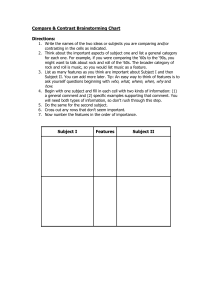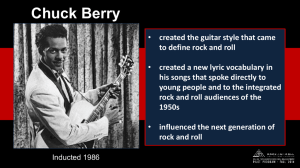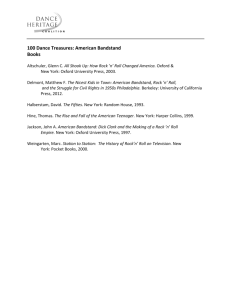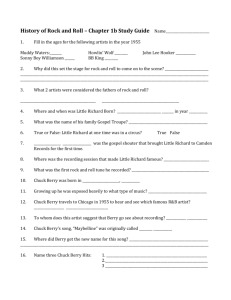Day 1 - West Ada School District
advertisement
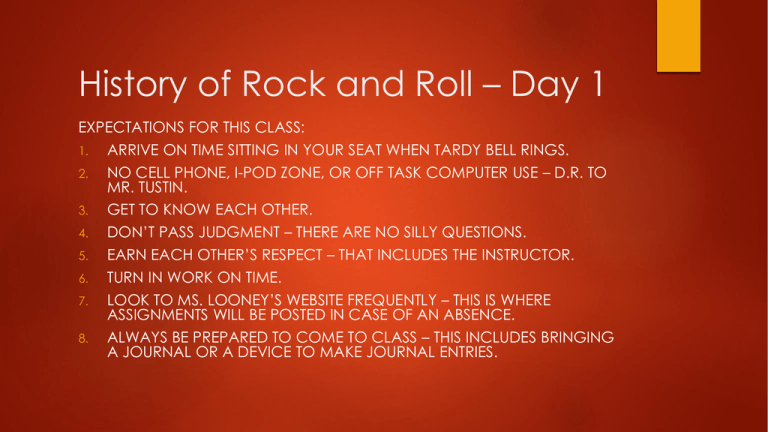
History of Rock and Roll – Day 1 EXPECTATIONS FOR THIS CLASS: 1. ARRIVE ON TIME SITTING IN YOUR SEAT WHEN TARDY BELL RINGS. 2. NO CELL PHONE, I-POD ZONE, OR OFF TASK COMPUTER USE – D.R. TO MR. TUSTIN. 3. GET TO KNOW EACH OTHER. 4. DON’T PASS JUDGMENT – THERE ARE NO SILLY QUESTIONS. 5. EARN EACH OTHER’S RESPECT – THAT INCLUDES THE INSTRUCTOR. 6. TURN IN WORK ON TIME. 7. LOOK TO MS. LOONEY’S WEBSITE FREQUENTLY – THIS IS WHERE ASSIGNMENTS WILL BE POSTED IN CASE OF AN ABSENCE. 8. ALWAYS BE PREPARED TO COME TO CLASS – THIS INCLUDES BRINGING A JOURNAL OR A DEVICE TO MAKE JOURNAL ENTRIES. Grade Weights Projects 30% (Including Journal Entries) Essays 30% In class work 30% EOC Paper 10% All work will be typed, MLA format, Times New Roman, 12 pt. font. Keep current on Ms. Looney’s website at all times for assignments and due dates. It’s up to you to bring in missed work in a timely fashion. Grade Calculations A - 90% – 100% B- C - 70% - 79% D - 60% - 69% F- Grades may be redone to achieve a higher mark within one week of getting the paper handed back. Late work will be considered incomplete and no late grade will be given. You will have three weeks to make up late assignments. Parents will be contacted for incompletes after three assignments are deemed to be incomplete. You will be asked to stay after school at a time that is convenient for the instructor to make up incomplete work. 80% - 89% 50% - 59% Ice Breaker Turn to the person on your left and introduce yourself. Learn all that you can about that person’s musical preferences (take notes), find out the person’s favorite group and song. After three minutes, switch roles and find out the same things about your partner for three more minutes. Tell the class about each other in a way that is entertaining and makes your partner memorable. Ice Breaker 2 Fill out the getting to know you questioner. Be complete. Write in complete sentences and paragraphs Turn in the handout to the instructor. Seating Chart To aid the instructor in recalling student name’s as quickly as possible, you will sit in alphabetical order during the semester. Move to assigned seats when teacher instructs you Day 2 begins here How to Study Rock and Roll Targets 1. Use a Listening Template to understand a song. 2. Use a timeline to understand historical context. 3. Understand Rock and Roll as a visual culture. 4. Understand Rock and Roll as performance. Essential Question: How can we learn to analyze and understand Rock and Roll? Songs are like windows into the world during the time in which they were made. Social, cultural, and political landscapes affected the artists and writers. We may not hear music through these lenses – we may be overcome by our own personal, emotional response to the music. Therefore, we will try to move out of the personal, emotional response mode and hear what the music is saying. Using a Listening Template to Understand a Song Distribute sample listening template. Follow along on listening template while we hear “My Girl” by the Temptations. http://viewpure.com/6IUG-9jZD-g Discuss the specific example Fill in the listening template while we listen to “Johnny B. Goode.” http://viewpure.com/6ROwVrF0Ceg What else was on the chart in 1958? No. 1 – “The Purple People Eater” http://viewpure.com/X9H_cI_WCnE In the Top Ten: Dean Martin – “Return to Me” http://viewpure.com/EpBjgQlT_jA Four Preps – “Big Man” http://viewpure.com/zXd8c1BLpRQ HOW DO THESE SONGS COMPARE TO JOHNNY B. GOODE? Historical Context Next, the aim is to expand the timeline to include significant events that are not immediately related to Rock and Roll. Below is a short list of events that might be used to explore the general time period around the recording of “Johnny B. Goode.” •Paul Robeson performs sold-out one man show at Carnegie Hall, 1958 •National Guard called in to Central High School in Little Rock, Arkansas, 1957 •American Bandstand, a local television show, joins ABC network, 1957 •Disneyland opens to public, 1955 •Passage of Federal-Aid Highway Act creates Interstate Highway System, 1956 In the case of Chuck Berry, what issue was the most obvious? In the pre-Civil Rights era, Berry was in the interesting position of being an AfricanAmerican entertainer whose audience was significantly white. The same teenagers who were watching American Bandstand, which went national on ABC in 1957, were hearing directly from an African-American musician who recorded for a Chicago label, Chess, focused primarily on Blues and R&B. It was an instance of racial mixing through music, and this in the same general period when President Eisenhower was using the National Guard to oversee the integration of a public high school. These two examples of racial mixing can, and should be, understood as related. To fully understand how the Civil Rights movement got traction in the 60s, one needs to go back and see what was happening in the 50s that set the stage. Understanding Rock and Roll as a Visual Culture: Film, TV, and Fashion The experience of popular music, however, is never just about sound. Since Rock and Roll’s beginnings, artists have always been seen as much as heard. Elvis Presley caused a certain furor on the basis of image alone. When people discuss the Beatles breaking into the American market in a big way, they talk about the band’s Ed Sullivan Show appearance. For artists of today, such as Lady Gaga, image is only that much more important. No surprise, then, that our study of Rock and Roll extends deeply into the visual realm. This level of analysis is about the look — fashion, the body, and televisual, photographic, and cinematic presentation. Rock and Roll as a Visual Culture. What these contrasting images point to is a shift in African-American culture that happened in the space of a few short years, as the mid 60s gave way to the 70s. Following Martin Luther King’s assassination and with the rise of the Black Power movement, there was a move toward a more “natural” look among African Americans — and African-American performers were often at the forefront of such change. The “afro” replaced straightened hair. Artists wore African Kente cloth. The locales in which artists were photographed often looked less like a studio and more like an urban street. And these developments were a symptom of deeper changes in how African-Americans were seeing their places in American life. The songs told a story; the images supported it. In the case of the image of Chuck Berry, there is a clear sense of how Berry was being pitched to a teenage audience. A classroom conversation about the artist’s presence within that context, about what seems to work and what doesn’t, would illuminate some of the more curious aspects of his immersion in that milieu. His self-presentation is often described as “clownish,” and here he exudes some of that. Two Faces of Rock and Roll at their Roots. The Last Poets http://thekey.xpn.org/aatk/files/20 13/08/The+Last+Poets.jpg The Supremes 1966 http://thekey.xpn.org/aatk/files/20 13/08/The+Last+Poets.jpg What was the purpose/significance of the two differing poses? Understanding Rock and Roll as Performance. James Brown – Alive at the Apollo Theater http://viewpure.com/D5JG27snLzM James Brown visual performance http://viewpure.com/BawGN9_FR8 (Start at 10:15) Which performance did you like better? Why? Why was this kind of performance looked down upon by older generations?
